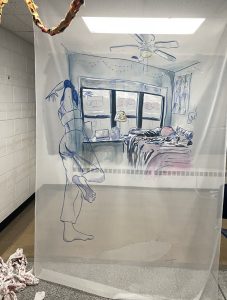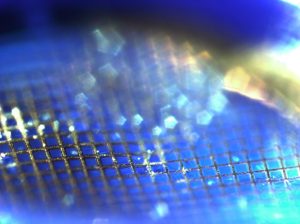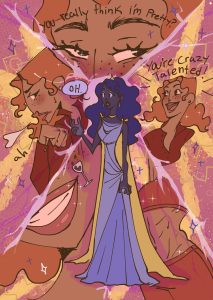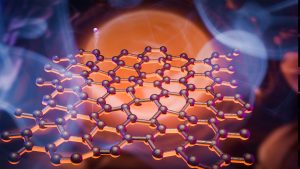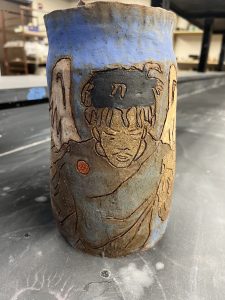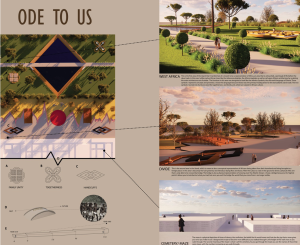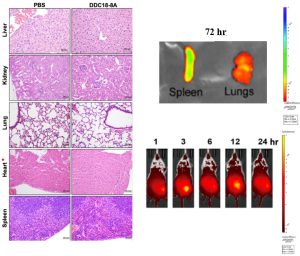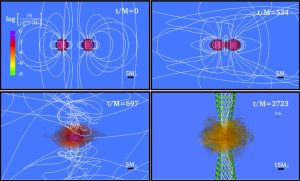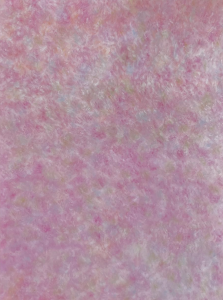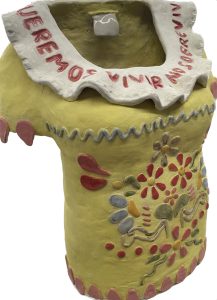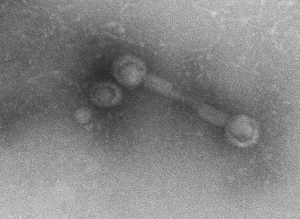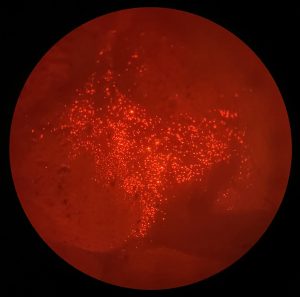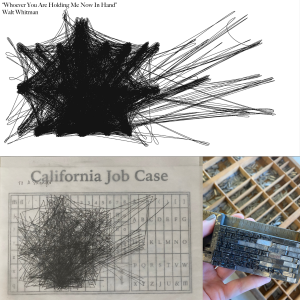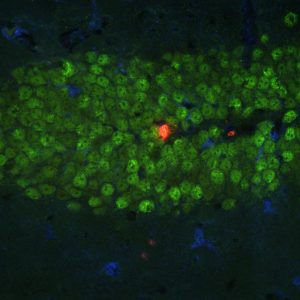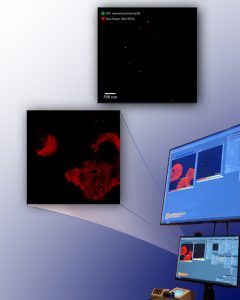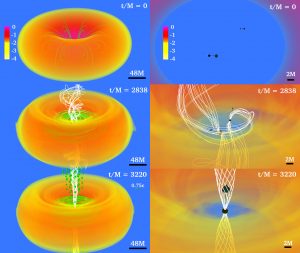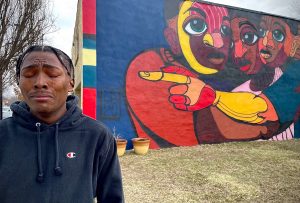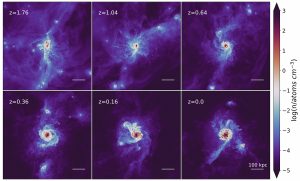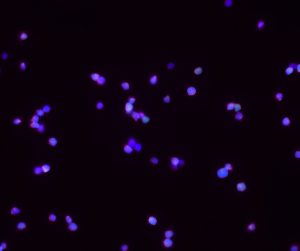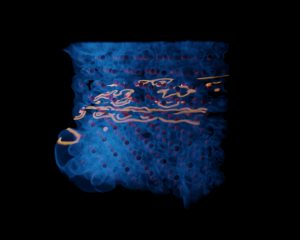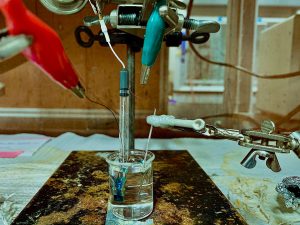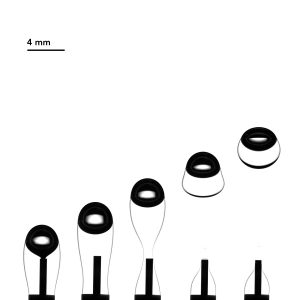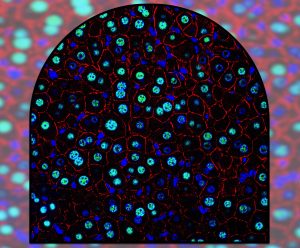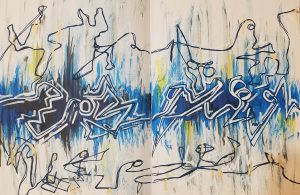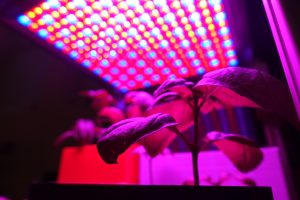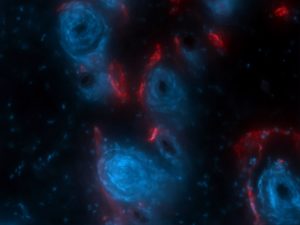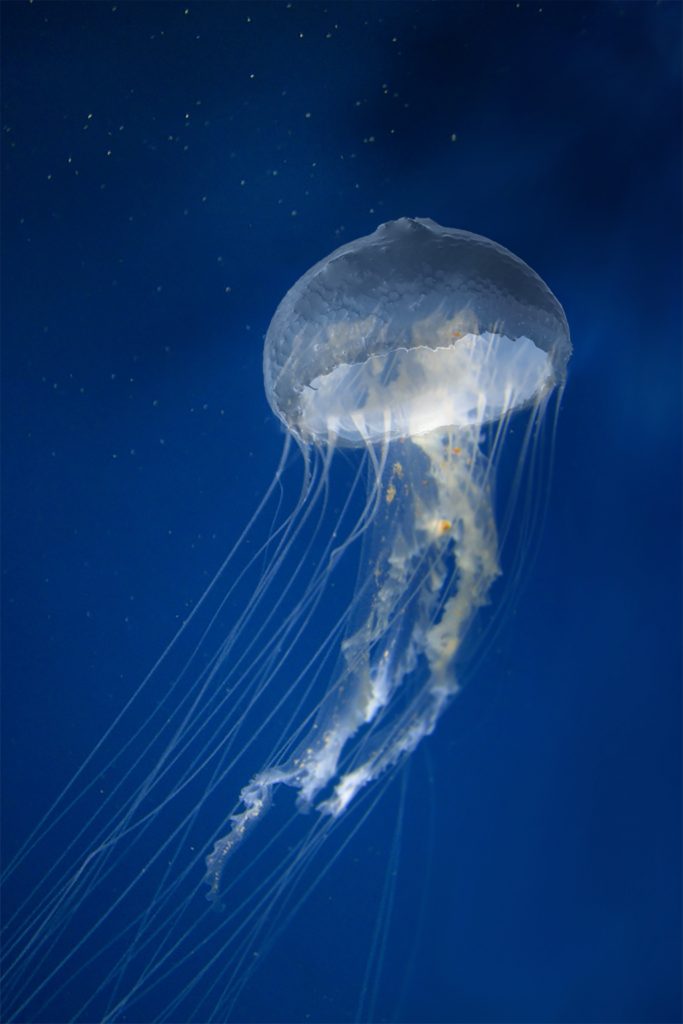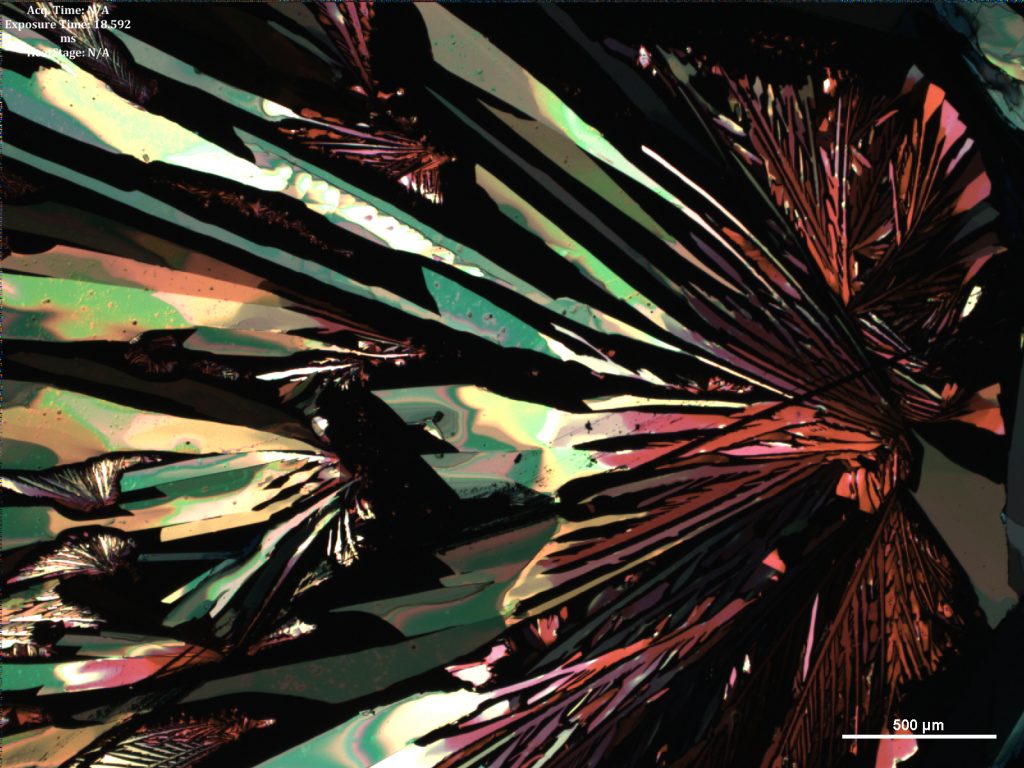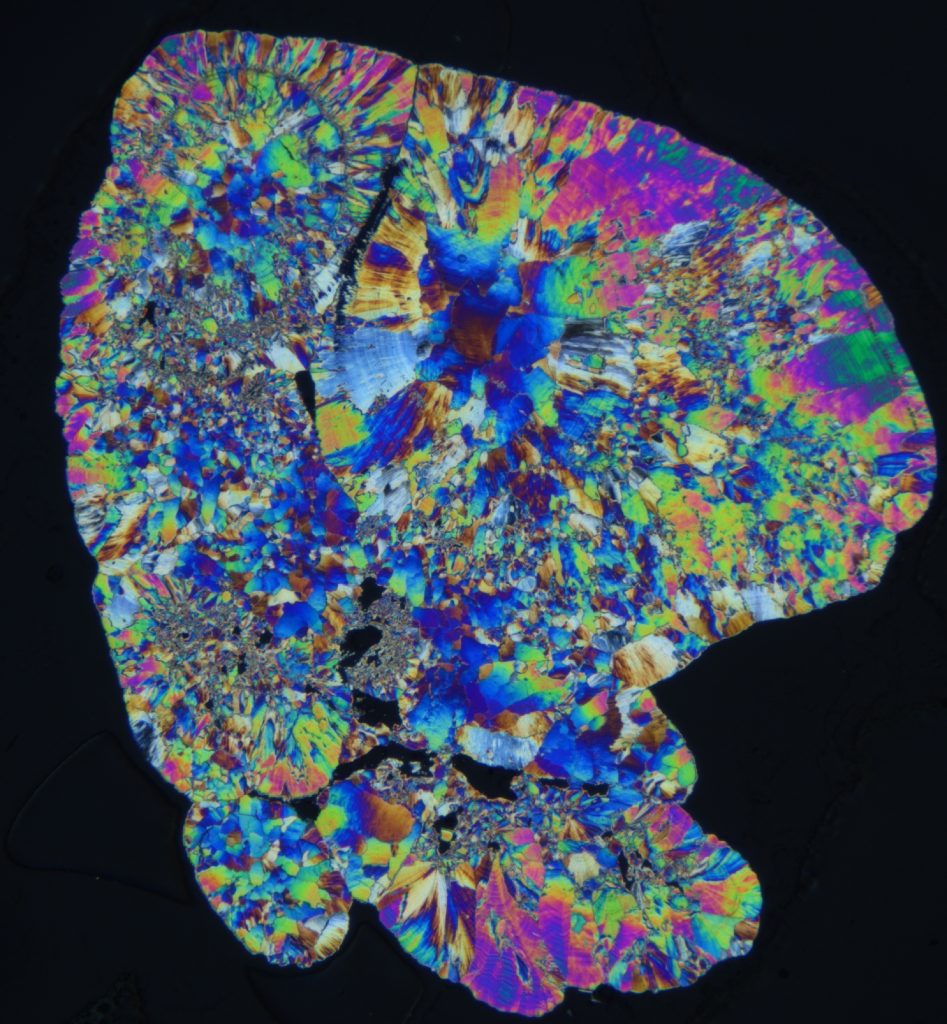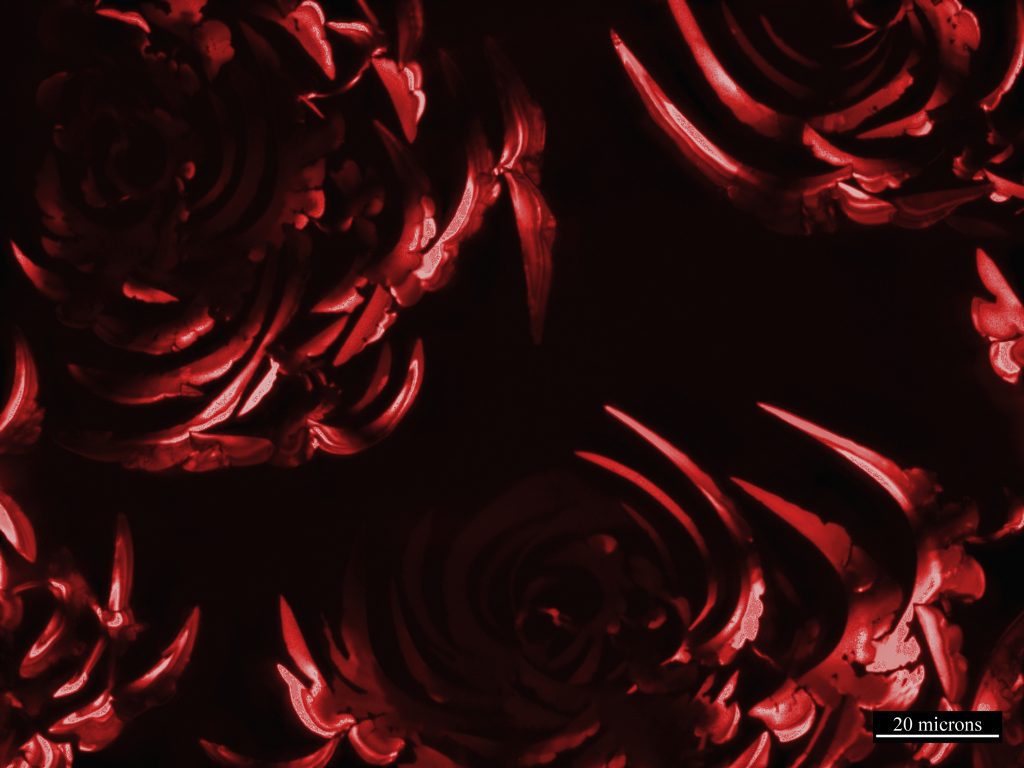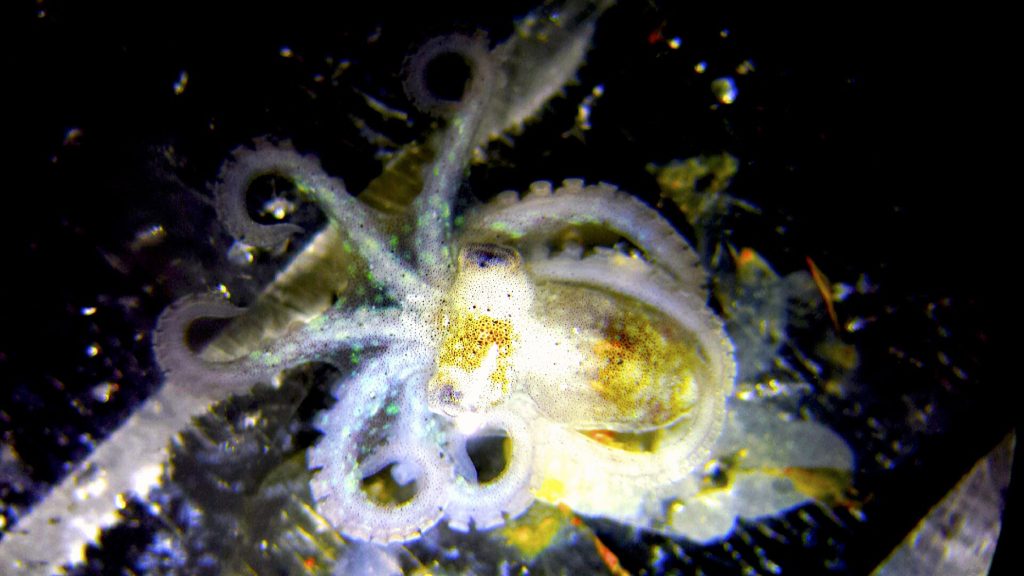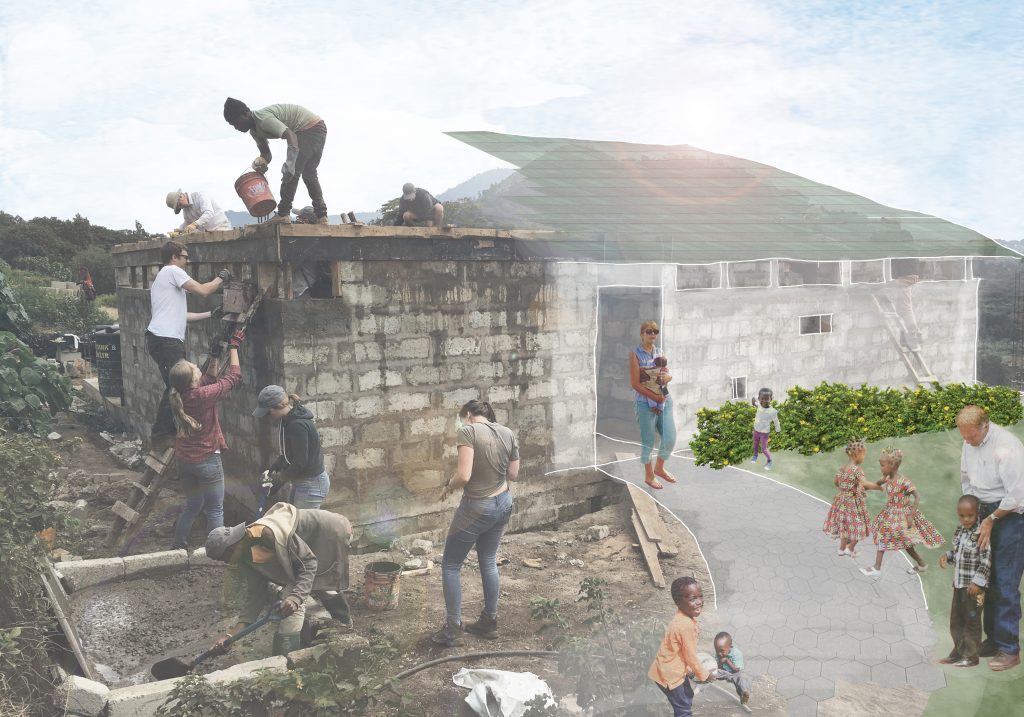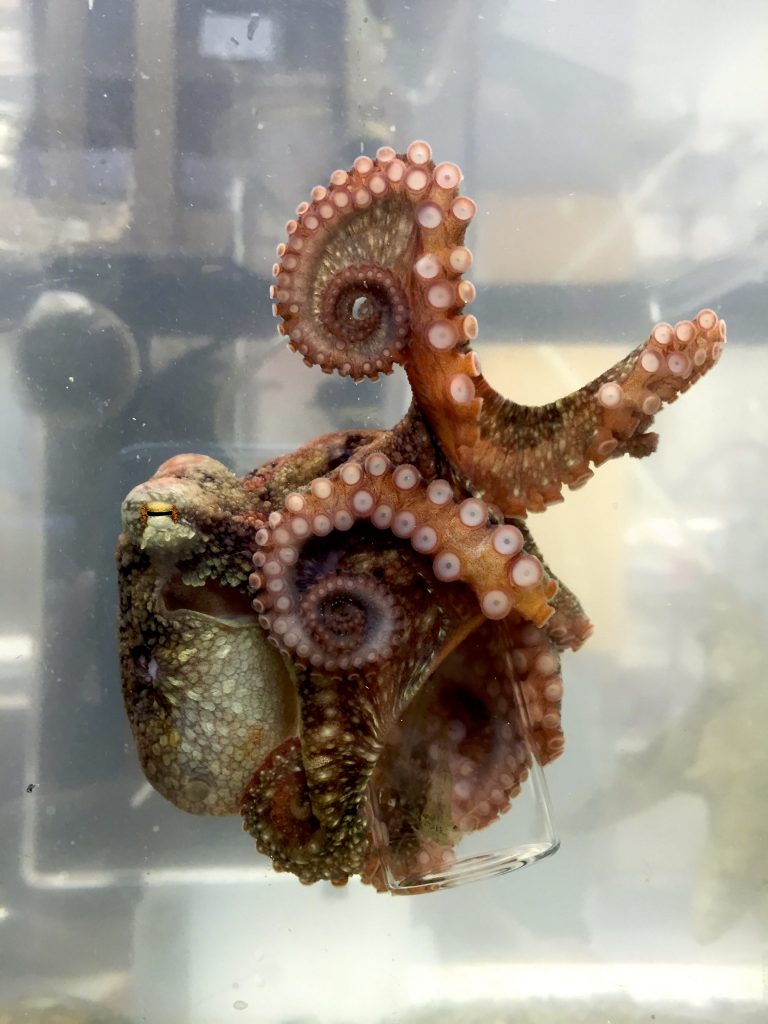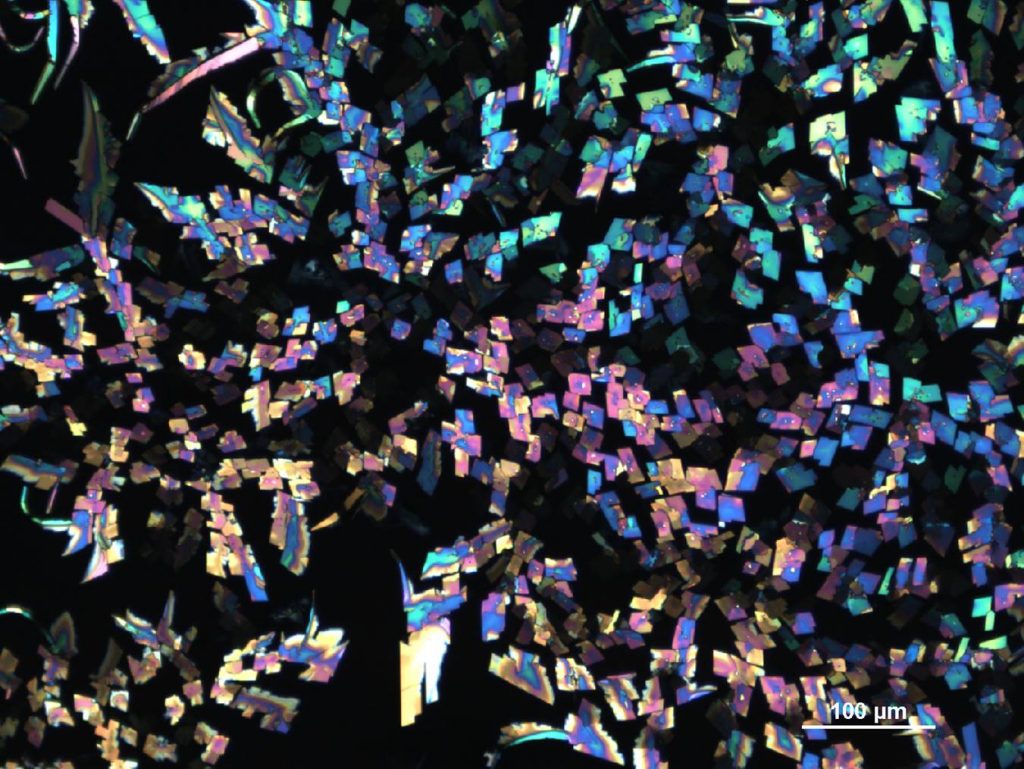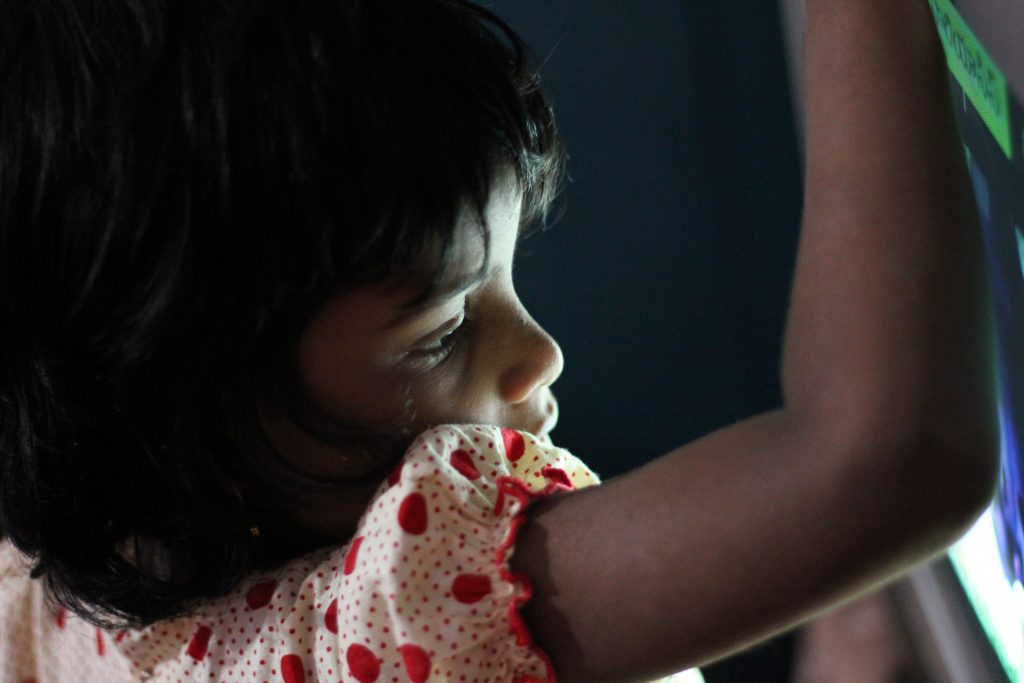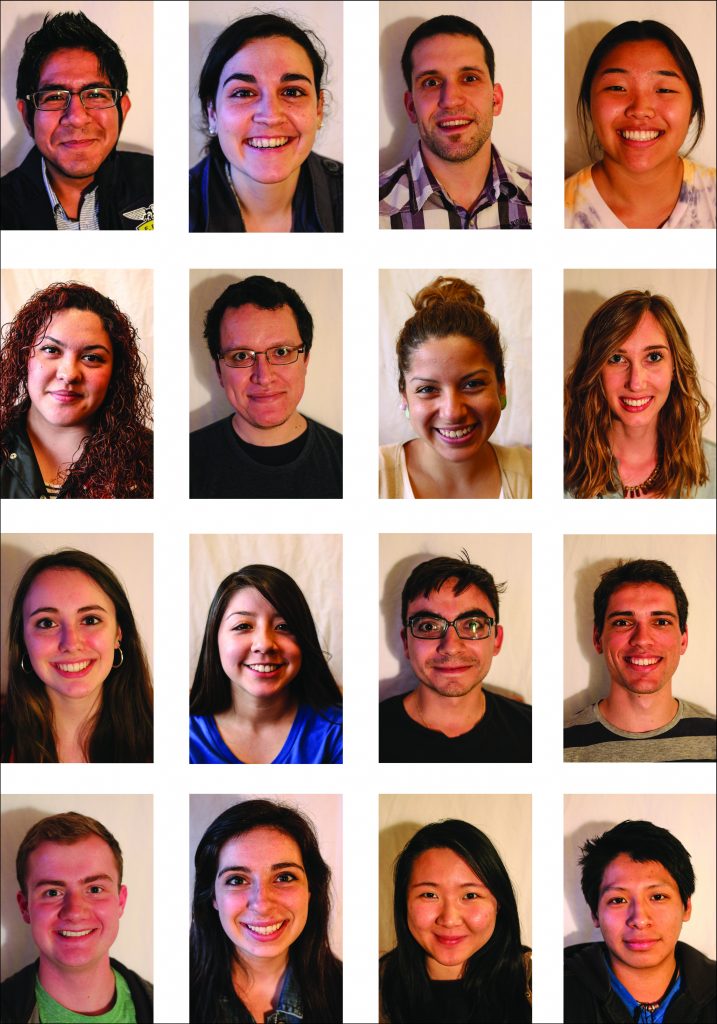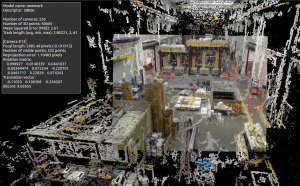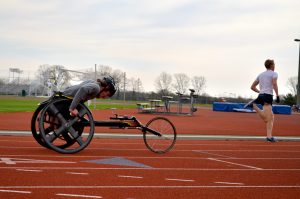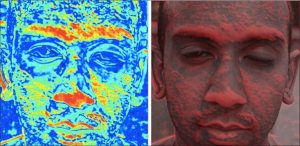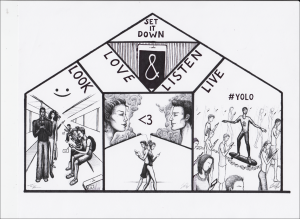2024 AWARD WINNERS
FIRST PLACE $300 Award
“Don’t Hit Your Head on the Ceiling Fan, 2024” by Emma Haugh-Ewald (Studio Art) Faculty sponsor: Kira Dominguez Hultgren
“Don’t Hit Your Head on the Ceiling Fan” is the first piece in my ongoing series of scrim cloth paintings titled “Dancing Blinds”. I am interested in how my bedroom and private spaces can act as shadows and reflections of my own body, experiences of femininity, and memories. I am thinking about the body as a vehicle for experience as well as a medium that leaves marks on the things it interacts with. I like the way living bodies transfer stories onto objects, textures, homes, and spaces; making collections into self portraits. I take influence from the idea of autotopography, a term that was coined by Jennifer Gonzalez, that describes the way we use objects to “map” ourselves. This series of paintings pulls from this idea that the things we collect or accumulate, the ways we decorate our spaces, or the messes we create in our day to day are things that carry such rich, personal stories and histories. The sheer veil-like surface forces the viewer to put their own body in context with the work and enter into a private world.
SECOND PLACE $200 Award
“Visualizing the Unseen: Exploring Metal Nanoparticles through Transmission Electron Microscopy (TEM) and Automated Deposition Techniques” by Diana Pham (Mechanical Engineering)
Faculty Sponsor: Kelly Powderly
How do we “see” the shape, size, and elemental composition of a metal nanoparticle that is too small to visualize even with an optical microscope? The trick is to use highly accelerated electrons, instead of light waves, in an instrument called a transmission electron microscope (TEM).TEM grids are commonly used to support small specimens while allowing electrons to pass through for analysis. This photo is an optical microscope image of a carbon-coated copper TEM grid housed inside a cylindrical well in a blue 3D-printed mount. We have designed the mount to integrate and standardize the position and orientation of the grid on a 4-axis stage for the automated deposition of microarrays of 200-picoliter nanoparticle samples on a single TEM grid for high-throughput analysis. For scale, this TEM grid’s full diameter is 3 mm and each of the squares is 54 x 54 μm2 while the metal grid bars are 31 μm wide. The intensely focused light was angled and resulted in floating pentagonal reflections created from the pointed top edges of the metal grid lines. This photo was captured with a 100x magnification microscope in the Micro-Nano-Mechanical Systems (MNMS) cleanroom in the Mechanical Engineering Laboratory.
“Aawww+” by Dayanara Baez (Studio Art)
Faculty sponsor: Kira Dominguez Hultgren
My artistic research consists entirely of an exploration of human connection from a queer lense, preferably, a lesbian one. I choose to explore this theme through experimentation in shape language, color, and stylization of the human figure. As a storyteller at heart I express my themes through comics and illustrations. The likes of which can be easily summed up in the image chosen. This illustration focuses on two original characters of mine, a duo that has greatly defined my work for the past four years. They originate from my past web comic and continue their story through my work in progress novel. This specific piece depicts the moment in which one realizes her romantic feelings towards the other. Its intent is very obvious, I am not shy to depict sexuality and leave no room for any other interpretation. My work is unquestionably queer to push back on the past’s needs to conceal it for the safety of the individual. I have the privilege to do what so many before me could not, and I will do so, unapologetically.
“Revealing the Unseen: Visualizing Electron Dynamics in Graphene” by Noor Elbanna (Uni High student, taking CS 124 at UIUC)
Faculty Sponsor: Andre Schleife
I am interested in making scientific research more accessible by creating visualizations that capture the essence of atoms and electrons, which are challenging to photograph directly. By combining scientific data with art, I strive to make the scale of these particles more intuitive and tell compelling data stories to a broader audience. Here I show an artistic reconstruction of when a very warm graphene sheet is hit by a proton and loses electrons as a result. Its perfect lattice structure begins to warp because of the temperature. As sharp as an arrow we introduce a proton into the graphene matrix disrupting the perfect balance. In this controlled chaos, we watch the electron fog respond to the proton’s intrusion, weaving intricate patterns, revealing the graphene’s energy distribution. This image is inspired by the research results of direct numerical simulations from Professor Andre’s Group and crafted using Blender, a powerful open-source 3D computer graphics software. The background of the image was generated by Magic Media.
“Juice WRLD Ceramic Art Tribute” by Meyaz Hasan (Fine Arts)
Faculty Sponsor: Holly Strickland
In the summer of 2023, I was inspired by the music and legacy of Juice WRLD to create a series of ceramic artworks as a tribute to the late artist. His raw lyrics and emotional vulnerability resonated with me deeply, sparking a creative process that allowed me to express my admiration for his artistry through clay. As Juice WRLD once said, “I want to be remembered as one of the greats.” Through my ceramics, I aimed to capture his essence and immortalize his impact on music and culture. Each piece in the collection reflects different aspects of his persona – from introspective moments to vibrant energy – while paying homage to his unique style and influence on a generation By merging my passion for ceramics with my love for Juice WRLD’s music, I found a way to channel my emotions and creativity into tangible forms of expression. This project honors his memory and explores connecting art with inspiration from an iconic figure in contemporary music history.
“Ode to Us” by Londarius Hayes (Architecture)
Faculty sponsor: David Chasco
Ode to Us was designed to celebrate, honor, and memorialize the hardships, achievements, and contribution of Black people to society from the beginnings of slavery to modern day. It is meant to be an immersive experience that places visitors back in time, so that they have a firsthand experience of what it might have felt like to be captured, taken from their homeland, forced into slavery, and the amount of work it took to come out of these circumstances. Ultimately, Ode to Us is a physical representation and reminder of the experience and perseverance of black people.
“Effective, Safe, and Persevering”: A Novel Antibiotic, DDC 18-8A by Noah King (Integrative Biology, Honors)
Faculty sponsor: Gee Lau
An arms race persists between modern medicine and antibiotic-resistant bacteria (ABRB). In hospital settings, ABRB raises a serious concern by prolonging infections during hospitalization and involving vital organs like the lungs. New approaches are needed. A potential alternative is a molecule [DDC 18-8A or DDC] that exhibited high antibacterial efficacy against ABRB and self-assembling properties outside a living body. We applied DDC to a mouse model to investigate its efficacy and biocompatibility. The left image presents tissue samples of vital organs exposed to a control [PBS] and DDC. The insignificant findings between the control and DDC indicate that the dendrimer doesn’t induce any inflammation or toxicity in essential organs. The top right image visualizes DDC’s presence in the lungs and spleen 72 hours after abdominal injection. This implies that DDC eventually found a way to utilize our blood vessels and can travel throughout the body to combat infection! The bottom right image defines DDC’s longevity, biodistribution, and antibacterial efficacy. This mouse was induced with pneumonia from ABRB [methicillin-resistant Staphylococcus aureus] and treated with a fluorescent-marked DDC. Over time, we can see DDC travel into the mouse’s lungs and throat to combat pneumonia, and DDC lasted over 24 hours. DDC provided optimistic findings in combatting ABRB complicating human infectious disease.
A Cosmic Dance: Binary Neutron Star Mergers by Rohan Narasimhan (Physics)
Faculty sponsor: Professor Stuart L Shapiro
A single teaspoon of a neutron star weighs about 10 million tonnes. What happens when two of these primordial objects collide? Each of these images was rendered using some of the world’s most advanced supercomputers, showcasing vital moments of the merger. The neutron stars collapse into a supramassive remnant with its own accretion disk. The magnetic fields slowly collimate over time, forming a tightly wound spiral as seen in the final frame. The remnant eventually either stabilizes, or in certain cases, collapses into a black hole. We follow the stars across their million year journey, orbiting each other and slowly spiraling inwards. The merger itself however, is astonishingly quick, the stars collapse into a remnant within a couple of milliseconds. This unleashes a massive amount of energy in a spectacular explosion known as a kilonova. As researchers, we often tend to fixate over the minutiae of our work, but every once in a while I like to take a step back to marvel at these colossal celestial bodies ripping through the fabric of the universe.
Petals by Sujin Park (Art and Design)
Faculty sponsor: Kira Dominguez Hultgren
When people view paintings, they feel various emotions. While looking at the painting, the emotions and feelings depend on the person’s background or how one views the world. As time progressed, paintings became works of art that contained various meanings, away from the purpose of recording history. Objects exist in form, but there is no fixed form in the emotions we feel in our lives. Monotone abstractions were produced based on the question, “What if we express emotions abstractly on the canvas?” This painting is an abstract painting based on the petals on the floor and the thoughts of my life. There is no eternity and immutability in life. We can know that fact through changes in human nature, death, and emotions that repeat mistakes. Like the truth of life that flows to Sunridae, the season changes as time passes. Just as a brilliant spring comes after a cold winter, we must accept the given fate and cherish the present now. There is no immutability, but it is nature’s providence that humans return to nature after death. When the flowers bloom and fall, the petals fall and return to nature.
Queremos Vivir, No Sobrevivir by Melissa Rivera (School of Art and Design)
Faculty sponsor: Kira Dominguez-Hultgren
This piece is based on the violence towards women in Mexico. The lace positioned on the collar of the Mexican dress has a phrase meaning “we want to live, not survive.” It vocalizes the pleas of women in Mexico whose voices are drowned out due to the toxic masculinity, often called “machismo,” in Spanish. Machismo is a socially accepted behavior in Hispanic culture, which then justifies the violence towards women. The phrase “queremos vivir, no sobrevivir,” is commonly used in protests against mistreatment and brutality. The bodily silhouette of the ceramic piece depicts the absence of a woman that would have filled in the space, further implying the mistreatment of women.
Fabulous Phages by Anne-Farah Usman (Molecular Cellular Biology)
Faculty Sponsor: Asma Hatoum
Fabulous phages are everywhere, populated in our soil, water, and even in the human body; These viruses have the ability to infect bacteria. Outnumbering their prey by tenfold, they have a wide genetic variability, making them a useful tool in modern medicine. Though small, phages hold a mighty power in a time in which antibiotic resistant bacteria are on the rise. these particular E.coli infecting bacteriophages were collected from ferret feces, and through enrichment and amplification protocols, we were able to characterize these novel phages as belonging to the Myovirus family. By usage of Transmission Electron Microscopy (TEM), phages can further be characterized and identified, expanding our knowledge and furthering research endeavors in the field of microbiology. Through TEM imaging, we were able to observe its ridged tails and its smaller capsids size of 50nm (the head of the entity in which genomic information is stored). Lytic Phages, such as these, have the ability to selectively infect their host, hence facilitating the targeted eradicating of their host strain. Classification and characterization of phages can aid in determining therapeutic treatment to bacterial infection, and although underused in medicinal treatments, these fabulous phages reveal a marvelous world only seen through 40’000x magnification.
Painting the brain red with mCherry by Lara Villano (Molecular and Cellular Biology)
Faculty sponsor: Patrick Sweeney
Like picking the darkest cherries off a cherry tree, the mCherry tag also responds to specific wavelengths of light by emitting a red fluorescent light between 550-650 nm, while absorbing light between 540-590 nm. mCherry originated from DsRed of Discoma sea anemones, and is widely used due to fast maturation capacity, pH resistance, and low molecular weight, among other qualities. It is often used as a fluorescent reporter to observe the roles of specific cell types or localization in feeding behavior or physiology. This image shows a viral mediated mCherry tag, that we stereotaxically injected into the ventral tegmental area (VTA) of a mouse brain. Our research works to harness the power of fluorescence to accurately deliver viruses to the selected region of mice brains. Our goal was to target the dopamine neurons, as the VTA transmits information to midbrain dopaminergic neurons, and this photo visualizes the viral activity, through fluorescence of the mCherry tag, around the given region. This ability to target specific brain regions allows for progression in many research projects, and from this tag specifically, we were able to determine the correct coordinates for viral injections into the dopamine neurons in the VTA of a mouse brain.
ALL AUTHORS RETAIN COPYRIGHT TO THEIR WORK.
Congratulations to all of the winners and thanks to everyone who entered the competition!
All of the entries from this year’s competition will soon be archived in IDEALS.
Many thanks to all of the participants in this year’s competition, and many thanks to the 2024 judges:
- Jenni Diaz Garcia (Graduate Assistant, University Library)
- Merinda Kaye Hensley, (Research Programs Liaison and Instruction Librarian), Chair
- Chris Holmes (Associate Director, Office of Undergraduate Research)
- Stephanie Luke (Metadata Librarian)
- Megan Tafalla (Undergraduate, Orange Room, University Library)
- Mary Ton (Digital Humanities Librarian)
- Elizabeth Rockman (Associate Director, Campus Honors Program)
- Trix Welch (Graduate Assistant, University Library)
2023 AWARD WINNERS
FIRST PLACE $300 Award
“Composing Whitman: Mapping Typography” by Keely Kuester
Composing Whitman makes visual the paths carved through space by the human hand: from letter to w0rd, from chaos to meaning. While setting movable type at Skeuomorph Press, my attention was drawn to the patterns certain words made as I moved my hands from one letter to another. Anyone setting the word “the” using a California Job Case, for example, begins down at ‘t,’ moves up to ‘h,’ and over to ‘e.’ Across time, any compositor forming a given word, sentence, or entire poem has executed roughly the same paths through space. Composing Whitman visually charts the typographical choreography of Walt Whitman’s Leaves of Grass. Whitman, a compositor himself, is an especially compelling example for visualizing the practice of typesetting because he hand typeset his first edition of Leaves (1855). Using JavaScript, I mapped each box of a standard California Job Case (in which “sorts” of lead type are stored) to a character. The result outputs the journey from letter to letter within the case, including the spacing between words. This mapping allows us to see Whitman’s own movements during typesetting, echoed in the present by any individual setting his work, giving even individuals without access to a print shop a sense of the historic practice of typesetting.
SECOND PLACE $200 Award
“The Chosen Neuron” by Prithika Ravi
This neuron is the chosen one. In this mouse brain, this one neuron is the manifestation of a tiny mouse running up to 40 kilometers a day, over multiple weeks. The physical exertion of the exercise on muscles leads to a cascade of biochemicals released that eventually cross into the brain to work their magic and induce the growth of new brain cells, or neurogenesis. My research as an undergraduate explores the exact mechanism of exercise-induced neurogenesis. For new neurons to survive their journey and fully integrate into the hippocampus, they must survive treacherous conditions, and prove their mettle by communicating with other neurons that they deserve to be an important part of the learning and memory center of our brain. This neuron is stained a vibrant red and green, the red representing its immaturity and the green representing its established status as a neuron. Although this neuron has proven its worth, it must work hard to keep up with the already seasoned neurons that surround it, as shown in green. This neuron is the chosen one, the one that made it.
PEOPLE’S CHOICE $100 Award
“Magnifying a Molecule: MINFLUX Nanoscopy of an HIV-Infected Cell” by Neha Arun
The Minimum Photon FLUX (MINFLUX) developed by Abberior described as the “world’s most powerful fluorescence microscope,” can achieve a resolution around the single molecule level (1-3 nanometers), essentially making it a nanoscope (Gwosch et al., 2020). This super-resolution tool presents an unprecedented method of resolving the structure of a human immunodeficiency virus (HIV)-infected cell. Upon infection, HIV’s integrates into the host cell where it hides from the immune system. The difficulty of eradicating this “latent reservoir” of cells which can become reactivated during treatment interruption is why HIV remains without a cure. My research seeks to define how HIV hijacks human host proteins to facilitate virus spread upon reactivation, which requires a detailed understanding on the molecular level. Here I combine my passions for multimedia editing and research to present a visualization of how it felt to zoom into this cell during MINFLUX acquisition until I was almost seeing individual molecules interact. Many people have to “see it to believe it,” and this is possible with the MINFLUX at the Institute for Genomic Biology (IGB), only the third of its kind in the United States. Images were captured with the help of Dr. Kingsley Boateng at the IGB.
ALL AUTHORS RETAIN COPYRIGHT TO THEIR WORK.
All of the entries from this year’s competition are archived in IDEALS.
Many thanks to all of the participants in this year’s competition, and many thanks to the 2023 judges:
-
Sarah Blanco (Library Specialist, University Library)
-
Libby Cave (Graduate Student, University Library)
-
Lonnie Clark Jr. (Library Specialist, University Library)
-
Merinda Kaye Hensley (Research Programs Liaison and Instruction Librarian)
-
Eric Kurt (Media Commons Coordinator, University Library)
-
Elizabeth Rockman (Associate Director, Campus Honors Program)
-
Karen Rodriguez’G (Director, Office of Undergraduate Research)
2022 AWARD WINNERS
FIRST PLACE $300 Award
“3D Visualization of Binary Black Hole Merger” by Mit Kotak
What happens when two black holes merge? Spectacular new images show the magnetic swirl action like never before.
By simulating this merger on a supercomputer, we can understand astronomical observations made by NASA and ESA telescopes. Our research focuses on developing mathematical models to couple Einstein’s equations, which describe the gravitational field around a black hole, with equations that govern the motion of matter moving close to the speed of light in a magnetic field.
The image grid was created by solving these equations on a supercomputer over a span of 6 months. The t/M metric tracks simulation time and the scale bar at the bottom helps calculate black hole mass. The jets coming out of the black holes can be detected by electromagnetic emission detectors whereas the colorbar contains information about light intensity fluctuations that can be detected by large telescopes such as Pan-STARRS in Hawaii.
Images like these not only help researchers analyze the behavior of spacetime around black holes, but they also offer a lesson in humility; black holes remind us that no matter what we do, there will always be things out there in the cosmos that continue to elude our wildest imaginations.
SECOND PLACE $200 Award
“Too Cool to Cry” by Jaylon Muchison
Captured below is the grief of a young Black man turning away to cry in solitude. Watching him attempt to conceal his tears from embarrassment, a mural of a black family responds to this public vulnerability with concern and confusion. My study deals with young Black men and spaces where they feel safe or threatened to cry in. There are public and private spheres of vulnerability, with private locations as the most preferred. Social media and social cycles teach young Black men that expression of emotions in a vulnerable and public manner, such as crying, leads to emasculation, embarrassment, and scrutiny. This prompts the reaction that “crying is weak.” Due to socioeconomic status, affiliation, or household role, weakness is a trait many Black men cannot afford. Many turn to coping with “coolness,” instead: escapism with drugs and alcohol, expression through anger or violence, or isolation. This theory from Richard Majors and Janet Mancini Billson discusses how Black men defend themselves against the inequities of our society. “Coolness” suppresses vulnerability and has direct links to overrepresentation of Black men in reported cases of suicide (11%), depression and anxiety (24.6%), and homicide (55.5%) despite only being 6% of the U.S. population.
HONORABLE MENTION $50 Award
“Evolution of a Milky Way-like Galaxy and its Satellite Galaxies” by Bhavya Pardasani
The panels depict the gas density in a simulation of a Milky Way-like galaxy (“Louise,” at center) as it consumes smaller satellite galaxies over a period of 10 billion years. From top to bottom and left to right, the images show Louise and the surrounding galaxies every 2 billion years until the end of the simulation (z=0 or today). The simulation is meant to represent the evolution of our own galaxy and how it interacts with and has been built up from smaller galaxies. The small dark/bright spots in the gaseous host halo are infalling low-mass satellite galaxies that are consumed by the larger host galaxy. The snapshots show how satellites that fell in earlier no longer exist as independent galaxies, but they leave behind dense trails of gas in the local environment illustrating the path of the pre-existing satellite. This figure exemplifies my efforts to study the evolution of the Milky Way and its satellites via cosmological simulations, focusing on the hydrodynamic interactions of the gaseous halo surrounding the Milky Way with the gas in satellite galaxies.
HONORABLE MENTION $50 Award
“Pink, Green, and the Cure to HIV” by Neha Arun
Upon first glance, it’s an abstract scattering of colorful blobs across a dark background, which reveal some hints of pink and green following closer inspection. Enticing hints of color that my eyes have been begging to detect over the past six months. This is an image of fluorescently stained cells that are expressing the HIV provirus.
In Dr. Collin Kieffer’s lab since my freshman year, I have investigated HIV, the causative agent of the AIDS epidemic, which is responsible for 38 million current infections and 36 million total deaths worldwide. My current project seeks to understand aspects of the HIV life cycle during infection, to define how the virus operates in a state of producing virus (active) vs. dormant integration (latent), and advance towards a cure.
This image captures my first successful experiment, demonstrating efficient latency reactivation and virus production in a majority of cells, as represented by the fluorescent pink and green. Though it took half a year of failed experiments and dead ends, this image of triumph represents a step towards evaluating next-generation HIV drugs to combat the latent reservoir, which remains the greatest current roadblock to an HIV cure.
ALL AUTHORS RETAIN COPYRIGHT TO THEIR WORK.
2021 AWARD WINNERS
First place $300 award
“Penalized Information-relaxation Bounds for Airline Recovery” by Bingyu Zhou
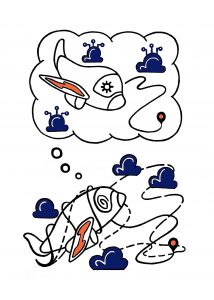
Large-scale airline recovery management is a near-real time dynamic programming problem that designed to manage the airline flight networks. Our research focus is on the algorithm improvement for the minimum cost route selection for airlines’ disruption management. The image presented is an abstract artistic illustration on the research focus. The airplane’s choice consists of many interconnected routes, but an algorithm needs to decide the optimal path with the help of data and computational technologies. Another message behind this artistic illustration is that we, often faced with the inadequate information and numerous uncertainties during our research, and even in our life, need to find the optimal path to our own destination, hopefully with the help of these technology improvements.
Second place $200 award
“Visualization of Isosurfaces of Electron Density” by Zixuan Chen
I built this visualization of isosurfaces of electron density in Blender. The image is a snapshot of electron density that is ejected from a thin piece of aluminum after an energetic proton impacted the material. These processes happen in radiation environments, including nuclear reactors and outer space, but are also used in research labs to manipulate and characterize materials. From visualizations like this, we learn how the radiation affects the material and the time scales following ion impact.
Honorable Mention $50 award
“In clenches” by Isabel Hughes
I am fabricating Platinum nanoelectrodes capable of detecting minuscule amounts of reactive oxygen species in cancer cells. The cutting edge aspect of my work is that I am working to be able to detect smaller amounts of these species than ever before by plating my electrodes with Prussian Blue complexes. This image depicts the cyclic voltammetry set up in a Faraday cage for plating my electrode with Prussian Blue and detecting the reactive species. Because this research has to do so much with cancer treatment, a disease that has evaded scientist’s curing, the pictured alligator clips clench onto a potential cure.
Honorable Mention $50 award
“Compound Bubble Dynamics” by Amrit Singh
Gas bubble dispersions in liquid media are ubiquitous in nature and industry. Often, such gas bubbles are enclosed within a layer of particulate matter or within a liquid that is different from the surrounding media, resulting in a three-phase compound bubble interface. Shown here is the underwater formation of a gas bubble within a droplet of silicone oil. This process, too quick and small to discern with the naked eye, is revealed through the wonders of high speed photography. Captured at 2000 frames per second, the bubble pinch-off dynamics can be carefully analyzed and quantified. Through our research, we hope to enrich the theory of compound bubble dynamics, resulting in better models that can be applied to a wide range of fields such as power generation or water desalination. So the next time you’re sipping a glass of champagne or enjoying a foam bath, spare a thought for the humble bubble – there’s much more going on than meets the eye!
– The 2020 competition was canceled due to COVID –
2019 AWARD WINNERS
First place $300 award
“A Fenestrated View into the World of the Hepatocyte” by Miranda Gurra
Hepatocytes, the parenchymal cells that proliferate in the fetal liver, constitute 80% of the liver and are an integral part of liver function, shape, and size. This is an immunofluorescence stain showing the composition of liver tissue: the teal reveals the nuclei of hepatocytes, red is the outline of the cell membrane, and the dark blue shows the nuclei of non-hepatocyte cells. This image, just like a stained glass window, tells a story. A story so complex and fascinating of how the liver works to detoxify your system, control metabolism, and keep you alive. These relatively large cells, invisible to the naked eye, are paramount during the first pass effect, where the liver metabolizes xenobiotics to protect the rest of the body. Without hepatocytes, medications and food normally consumed will not be broken down into the smaller components that your body is able to use. Hepatocytes are windows to your soul… and survival.
Second place $200 award
“Move Shift” by Mary Kate Ford
My research investigates choreography that uses the kinesthetic experience of making visual art to inform the way I move, assemble movements, and create atmospheres. One practice that I engage with when intersecting a curiosity for visual art making and dance is to blind contour draw movement that I see. From there, I spend time embellishing what is on the paper to understand the priorities that came to light when transposing an ephemeral movement onto a flat picture plane. I aim to not capture exactly what I saw and instead depict a phenomenological experience of witnessing dance, which feels closer to the totality of what live dance spaces contain. This practice is a rich way for me to research my own aesthetic observations, a unique way of looking at the moving body, and a way of beginning a process of making dance phrases for choreographic research.
Honorable Mention $50 award
“LED Farming” by YoungJoo Yoon
Over 6 billion people will live in urbanized metropolitan areas in 2050. Food shortage and overpopulation will be inevitable. This photo shows basil plants grown with LED farming technology. They have been observed in different heights under the same condition to find out the effect of the position of LED lighting on the plant growth. If LED farming is properly implemented, not only would it increase the crop yield but also it can be grown in a well-controlled environment without pesticides. Furthermore, LED farming requires less use of water and land, which will positively help the environment. We have chosen LED lights as a light source because it has the longest lifespan and it is much more energy efficient than any other lighting system. Also, LED lighting can emit an optimal wavelength for the plants to accelerate their growth. Since this is such modern technology, finding out the impact of the position of the LED lighting could help the future of agriculture.
Honorable Mention $50 award
“Ancestors and Astronomy to Scientists and Cancer” by Than C. Huynh
Astronomy is the oldest science. Even records of the earliest cave paintings depict prehistoric humans gazing at the stars and tracking their positions. Across cultures, the interpretation of the darkness and its stars provided insight into all aspects of life and has guided humanity for thousands of years. Connections between what was seen looking up and how the world changed around them, derived into a reliance on the stars for navigation and as predictors of weather for agriculture.
In the field of cancer biology, instead of looking up for answers, we look down into a microscope. Like our ancestors, we look for signs as we gaze into the unknown. We look for patterns and connect these patterns to health and disease. The image is of a Melanoma tumor slice. With the advance of imaging technologies, we can see and track the position of cells (blue) and other structures within tissue such as blood vessels (red). In doing so, we hope to make a connection between what we see looking down and how these markers change when diseased. In a sense, imaging is our guide for navigating and predicting the unknowns of cancer.
ALL AUTHORS RETAIN COPYRIGHT TO THEIR WORK.
2018 AWARD WINNERS
First place $300 award
“Fassi Tanner” by John Rossi
This image, taken in the tanneries of Fes, was captured during my semester abroad in the kingdom of Morocco during Fall 2017. Despite departing to research political and economic effects of North Africa’s Arab Spring, I also embarked on a journey to capture a glimpse of a hidden Morocco through my camera and to reflect the areas of my studies into my images. A visit to these tanneries will highlight the cross between the changing economics and cultures in the Maghreb, to those who look carefully. While Fes and its tanneries have operated as a knowledge hub and economic center for over 1,000 years, today they serve primarily as a tourist attraction, where visitors like those from Europe, America, and China can watch the workers and purchase souvenirs. As unemployment rises, especially among the Moroccan youth, more and more citizens take jobs serving tourists, both in the formal and informal sectors of the economy. NGOs, co-ops, and organizations such as the UN Economic Commission for Africa are working to spur sustainable, youth-centric development not only in Morocco but across North Africa and the rest of the continent. This image is a part of my “Morocco in Light” photo essay.
Second place $200 award
“Masquerading Jelly” by Heer Majithia
Jellies, 97% water, are little more than pulsating bells with trailing tentacles. Yet, these creatures are remarkably varied in appearance and found in waters across the globe. The photograph depicts an SEM image of a ruptured microcapsule as the bell shaped body of the jelly as it releases the core material, which has been embellished with the tentacles along with the color for enhanced impact. Much like jellies, microcapsules are found in diverse environments and can have a wide range of applications from drug delivery and phase changing materials to cosmetics and cleaning supplies. Microencapsulation of materials is beneficial as it increases their stability and allows for controlled release of the encapsulated material. My work is focused on the fabrication of multi-responsive microcapsules which can be triggered to release the core material by multiple mechanisms while maintaining stability under ambient conditions.
Honorable Mention $50 award
“A Happy Accident” by Nicole Jugovich
In the words of Bob Ross, “We don’t make mistakes, just happy little accidents.” The organic semiconductor crystals pictured in this image were the result of a “happy accident” in which I prepared a solution using the wrong solvent. I placed a drop of solution on a substrate, and this crystalline structure formed as the solvent evaporated. My research aims to deepen our understanding of how single crystals form and what causes crystals to adopt different characteristics. These organic semiconductor crystals may one day be used in many electronic devices. However, the crystal formation process must be studied more in-depth before these organic crystals can be used on a large scale. Some advantages of organic electronics over their traditional inorganic counterparts include their low cost and flexibility. Crystal research could not only potentially improve the overall quality of organic electronics, but it could also lead to the discovery of inexpensive, efficient ways to create these materials. With enough patience, optimism, and methodical research, perhaps the findings will be a happy “non-accident!”
Honorable Mention $50 award
“Kidney Kaleidoscope” by Elena Wilson
This image represents the beauty and complexity of science, giving just a glimpse into the intricacies of the human body. Kidney stones are common, occurring in roughly 1 in 11 individuals, and are renowned for their excruciating pain and high costs to the healthcare industry. Each is a unique geologic record of development and dissolution, change and stability, art and science. Kidneys are responsible for ridding waste products from the body by making urine. Sometimes, minerals aggregate inside the kidney, making a stone and blocking urine flow. The exact mechanism of kidney stone growth is still unknown. The multidisciplinary approach based on analysis of images like these gives information on crystallization patterns, allowing for a creation of a minute to minute record of stone development. This information has the potential to be applied to other mineralization pathologies in the body, such as gallstones, osteoarthritis and cholesterol plaques on blood vessels.
ALL AUTHORS RETAIN COPYRIGHT TO THEIR WORK.
2017 AWARD WINNERS
First place $300 award
“A Semiconductor Rose by Any Other Name” by Rebecca Boehning
To quote Shakespeare, “A rose by any other name would smell as sweet”- however, the “roses” in my photo are not true roses at all. These miniature roses are made from organic semiconductor crystals. They are approximately 100 microns in diameter, which is the width of a human hair. While these crystals can reflect any color of light, I have colored them red to increase the contrast and enhance the imagination. My research focuses on understanding the crystal growth of organic semiconductors. While most semiconductor materials are inorganic, such as silicon, the compounds I work with offer an organic alternative. Organic semiconductors, if used effectively, offer several benefits such as flexible electronic applications and low energy manufacturing compared to silicon wafers. Before organic semiconductors can be used industrially, the underlying crystallization mechanism must be understood. While the image shown here would not make an effective electronic device, the rose-shape of these crystals abstractly portray their organic character. In the future, organic semiconductors can provide a viable alternative for commonly used semiconductors today– or, in other words, an organic semiconductor by any other name would work as well.
Second place $200 award
“Colorful Emotions” by Andrew Tran
Roses are red, violets are blue, and octopuses are green, yellow, and brown. Colors are important representations of emotions, whether in poems or in octopuses. Remarkably, the octopus already displays mastery in controlling its chromatophores – the cells in its skin that gives it the unique ability to change color – despite being only two days old. Our research studies memory integration in the peripheral nervous system of the octopus – can the octopus store memory in its eight arms? However, it would also be interesting to examine if the pigments themselves can store memory and display emotion without the need of a brain. Interestingly enough, we have already witnessed learning behavior through color change in the octopus. When threatened or angry, the octopuses would turn red, much like how our cheeks turn red when we are feeling frustrated. When communication from the brain to the arm is severed, the arm still retains the ability to change colors and interact with its surroundings. Understanding the meanings of these colors could shed light on how these organisms use color to communicate, and maybe if the green polka dots on the heart shaped tentacles of the octopus in the picture means ‘love’ or ‘back off’.
Honorable Mention $50 award
“Encouraging Excellence in Planning and Design Processes and Practices in Underserved Communities” by Jesse Han
The original image was taken from a design-build project in Arusha, Tanzania. I, along with 20 other students, partnered with a local orphanage, Neema Village, to design and build a permanent home for the unadoptable children, where they could grow up with a family until adulthood. The project was a successful case study of what architecture can do when it considers the public’s interest from the beginning, throughout construction, and to occupancy. When designing, we considered the vernacular architecture along with the desires of the orphanage and learned building techniques from local craftsmen. The home is almost completely furnished and ready to house up to twelve children and a host family. Public Interest Design is a relatively new field within architecture which engages designers to use their skills to improve environments of underserved communities. Literature emerged in the form of websites, guidebooks, project analyses, and critical reflection, providing specific recommendations for practice and documenting case studies and methodologies. This paper presents the results of a comprehensive review of this literature to evaluate the breadth of existing resources for Public Interest Design and will explore how effectively the resources inform the public and train the next generation of public interest designers.
ALL AUTHORS RETAIN COPYRIGHT TO THEIR WORK.
2016 AWARD WINNERS
First place $300 award
“The Octopus: Eight Arms or Eight Minds?” by Alexander Duman and Andrew Tran
Contributor: Rhanor Gillette
Octopuses expertly coordinate eight arms that contain as much as two-thirds of their entire nervous system. In fact, the arms are very sensitive and are capable of distinguishing between different textures in their environment. Our research aims to determine if learning and memory can be stored in the peripheral nervous system (PNS) of Octopus rubescens. In the picture, the octopus is using its eight arms to feel and learn how to unscrew the cap and reach the shrimp inside. We hypothesize that the arms are able to store tactile information in the PNS. To test our hypothesis, each octopus is conditioned to associate food with a roughtextured die and an electric shock with a soft-textured die. After training each arm, Lidocaine is used to block neural signaling between the PNS and central nervous system. Each die is then introduced to the arms and grasp time will be measured to determine if the PNS can store tactile information. This research has the potential to explain both the functions of the octopus nervous system as well as provide insight as to how our nervous system functions.
Second place $200 award
“Crystal Confetti” by Rebecca Boehning
Contributor: Ying Diao
My research focuses on growing organic semiconductor crystals. Due to the increasing popularity of computers and smart phones, semiconductors now power our world. In recent years, organic semiconductors have emerged as a potential alternative to traditional semiconductor materials, such as silicon. These organic compounds offer several benefits such as flexible electronic applications and low energy production processes (compared to silicon wafers). One common way to produce high quality organic semiconductors is via crystallization. In my research, I aim to grow large (1 mm), monochromatic crystals with defined edges. The fun (and challenging) part of growing crystals is the outcome is random! Sometimes I end up with Crystal Confetti, and other times I achieve the large, monochromatic crystals I desire. By determining favorable conditions, I hope to see the desired outcome more often. However, my undesirable samples still make great abstract art.
Honorable mention $50 award
“Navigating Autism During Early Childhood” by Keerthana Hogirala
Contributor: Susan Fowler
To understand how culture and income affects how parents seek medical and academic resources for their autistic children during early childhood, I travelled to Visakhapatnam, India to conduct field research for my thesis. That’s where I observed the child in this image, Keerthana. After meeting with parents, teachers, and medical professionals, I began to understand what little networked support was available for autistic children. Dealing with autism is undoubtedly complicated. Learning your young child has it in a country that doesn’t fully understand and accept neurological conditions nor support comprehensive research and education through efficient policy and funding is even more so. Solutions parents implemented were patched together from various, typically conflicting sources and mostly their own experiences. Keerthana’s mother, for instance, was highly adaptive, but that wasn’t always sufficient to help her daughter’s often hyper and indiscernible behavior, such as energetically clinging to the television for stretches of time, as shown in the image. But I saw great resilience where there was resolute familial support. Families pushed through and found a sort of isolated happiness focusing on the positive in their child. Ultimately, parents needed to feel a connection with their child as much as their child needed them.
ALL AUTHORS RETAIN COPYRIGHT TO THEIR WORK.
2015 AWARD WINNERS
First place $300 award
“Statistical Computing for Galaxy Modeling and Gravitational Lens Detection” by Sean McLaughlin, Physics
Contributors: Robert J. Brunner, Anupreeta More, Kavli IPMU
Strong gravitational lenses are a directly observable consequence of general relativity and one of the most exotic phenomena in the sky. However, they are extremely difficult to detect in survey images; though thousands are predicted to be visible from Earth, scientists only know of a few hundred. I’ve written a program that rapidly models the lensing galaxy and subtracts it away. It then looks at residuals in the image and analyses them for lens-like properties. This is an example of one of nearly a thousand simulated strong lenses the program was tested against. It shows the original image, the residuals after model subtraction, and the final result after the residuals have been analyzed. My advisor and I believe this technique shows promise as a strong lens detection technique in current and upcoming large scale surveys.
Second place $200 award
“The Linguistic Complexities of Complexion: Spanish and ethnicity in the United States” by Colin Anderson, Linguistics
Contributor: Rakesh Bhatt
Knowing nothing about the pictured people other than how they look, which of them do you think speaks Spanish? The answer may surprise you. My research is a sociolinguistic investigation on the intersection of ethnicity and second language learning in the United States. In our culture, Spanish has been racialized as Latino. This has produced a multi-faceted ideology that goes something like this: if you’re Latino you must speak Spanish, and if you speak Spanish you must be Latino; likewise, if you’re white, you probably don’t speak Spanish, or if you do, its probably bad Spanish. In light of these ideologies, it should be highly interesting to investigate the attitudes of English monolinguals toward white people who have learned Spanish as a second language and speak it with an authentic-sounding accent. I study how these speakers are evaluated socially in dimensions of solidarity and status, perceptions of their legitimacy in speaking a language associated with an ethnicity they do not belong to, as well as how second language accent and ethnicity act as warrants in being perceived as a legitimate Spanish speaker. If you’re still wondering which people in the picture speaks Spanish, the answer is everyone.
Honorable mention $50 award
“Thinking Like an Octopus” by Andrew Tran, Molecular and Integrative Physiology
Contributor: Jeffrey W. Brown
The goal of the research project is to better understand the development and organization of the peripheral nervous system of the octopus. These creatures have large ganglion in each of their arms; two thirds of the octopuss neurons are actually located in the arms nerve cords. Illustrated in the picture, the cluster of Octopus bimaculoides embryos shows early signs of intelligence. The baby octopi rapidly change color and texture using their specialized, color changing cells known as chromatophores. The minute the larvae hatched, they immediately were able to use their highly organized arms to see and mimic their surroundings. The arms also appear to work independently from one another and even serve different purposes. One arm may specialize in capturing food while the other is used for locomotion. In essence, each arm appears to have a mind of its own. Octopuses are intelligent animals, rivaling the brainpower of vertebrates such as dolphins and monkeys. Unlike these animals, octopuses are invertebrates. Understanding their intelligence may give clues to what features of the mind are universal and which are unique for different species.
ALL AUTHORS RETAIN COPYRIGHT TO THEIR WORK.
2014 AWARD WINNERS
First place $300 award
“Vision-based Construction Site Surveillance for Efficient Utilization of Resources and Safety Monitoring” by JunYoung Gwak, Computer Science
My passion lies in computer vision, a field of study which makes computer see and understand what people can. Since humans heavily rely on visual information, building a computer system which has the same visual sense has a significant meaning. With computer vision, computers can smartly interact with the environment and perform various tasks that could only be done by humans before.
The goal of my project is to automatically detect and track workers and equipments from video cameras and localize their position in 3D purely based on computer vision techniques. In this image, 3D position of the workers are displayed on the point cloud model of the construction site. Based on this information, computer can automatically alarm workers walking into a dangerous area. Also, managers can make better decisions about utilization of workers and equipments. I hope small gains in efficiency through my research could lead to an enormous cost savings on the $900 billion construction industry.
Second place $200 award
“Inclusivity through Sport” by Aimee Gottlieb, Recreation, Sport, and Tourism
I took this picture at a wheelchair track practice last fall. It tied in perfectly with the research I had been doing on sport and inclusion. Previously, people with disabilities have been excluded from mainstream society and sports, with a mindset where sports were a tool primarily for rehabilitation. Recently, there has been a global push to be more inclusive through sport in order to help achieve the Millennium Development Goals laid out by the United Nations. To be more inclusive through sport, a greater effort needs to be made to not only include people with disabilities in adaptive sports, but also through mainstream sports. Sport has this unique power of uniting people and making differences in ability seem nonexistent. Being inclusive through sport can create awareness of different disabilities, make participation have meaning for everyone, and encourage opportunities to play together. This picture encompasses the power of inclusivity through sport. The disability appears nonexistent and the competitive drive and love for the sport is central to the image.
Honorable mention $50 award
“Reading Physiological Signals from Faces” by Le Wang, Electrical and Computer Engineering
My research is on non-contact heart rate detection using temporal analysis of face video captured by ubiquitous RGB webcams. The cyclical movement of blood causes the color variations on the face, and the pulse via abdominal aorta and the carotid arteries. Heart rate is a critical vital sign of physical condition in medical diagnosis. There are also emerging needs for non-contact, low-term and accessible cardiac pulse estimation with wide applications in health monitoring, emotion assessment, and human computer interaction.
To investigate the relationship between temporal color signals on the face regions, I use cross-correlation to measure the similarity between color variations on different face regions. The image on the left is the cross-correlation coefficient map with respect to the signal extracted at the forehead. The image on the right is the overlaid result of a single face video frame and the correlation coefficient map. We temporally band-pass filter each signal to reduce noises. From the resultant map, we could see high similarity between color signals on skin regions and the spatial pattern emerged as caused by the underlying blood flow. Our main research goal is to develop robust heart rate detection in unconstrained environments.
Honorable mention $50 award
“Set It Down” by Tayana Panova, Psychology
This image is a combination of drawings I have done that reflect what I see on campus every day. I have observed that students on campus are constantly looking down at their phones and engaging with them, and my hypothesis is that this behavior can have negative social and psychological consequences. I am currently doing research on this topic as part of the psychology honors program, and my results have shown high correlations between maladaptive phone and Internet use with anxiety and depression. Previous research has shown that cell phone and Internet use is also associated with lower GPAs, unsatisfactory interpersonal interactions, sleep issues, and general psychological distress. This image attempts to convey some of the problems related with technology usage and propose a solution to set the phone down a little more often and look up, thereby engaging more with the world around us.
ALL AUTHORS RETAIN COPYRIGHT TO THEIR WORK.


